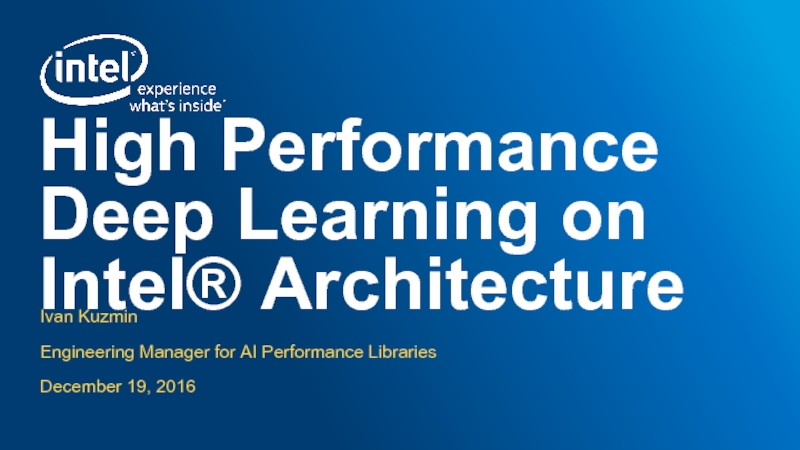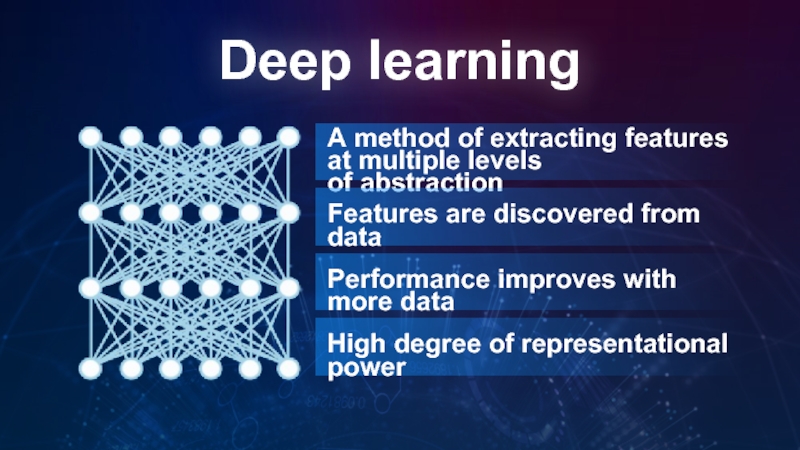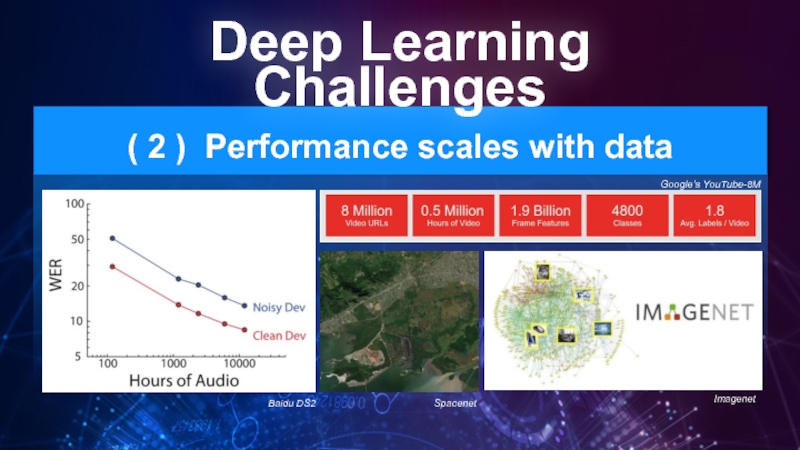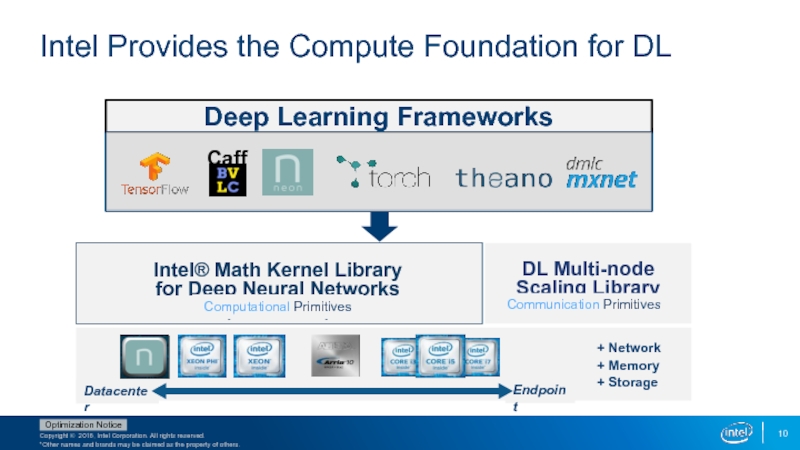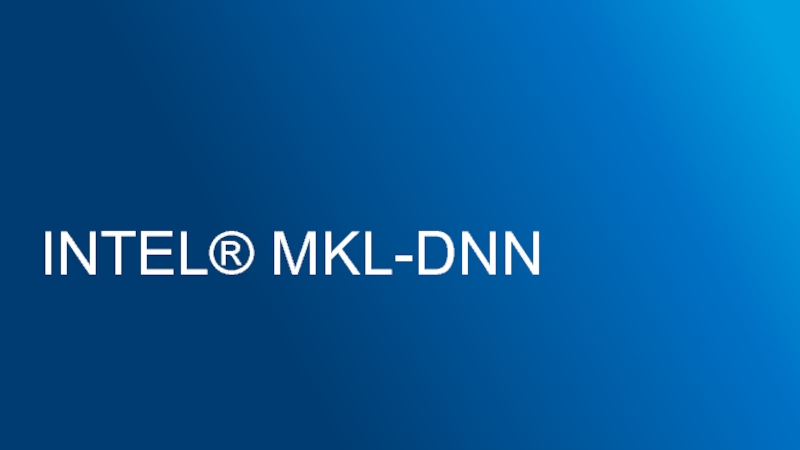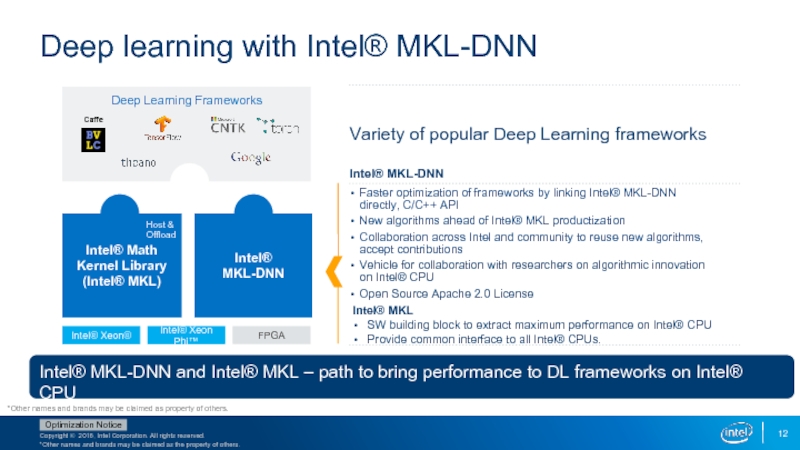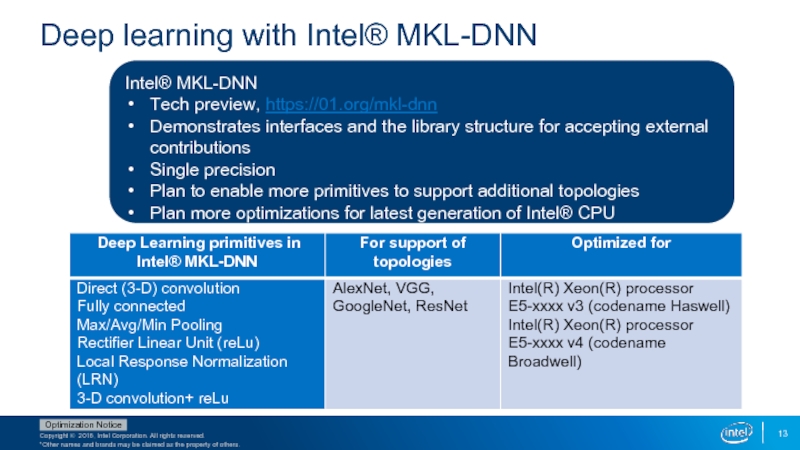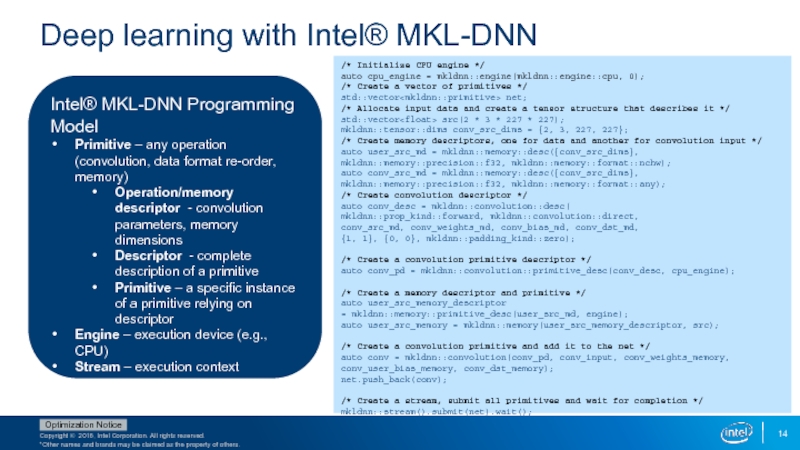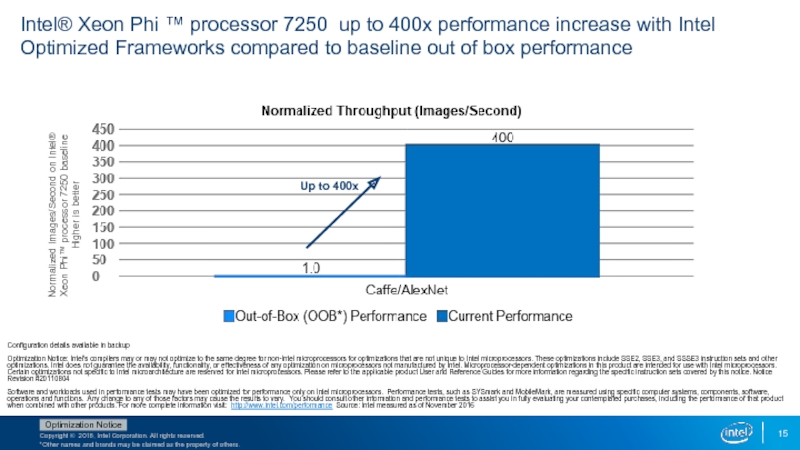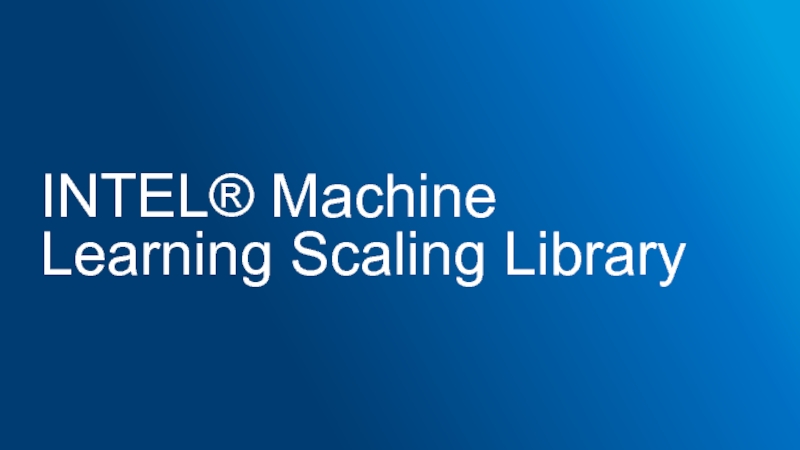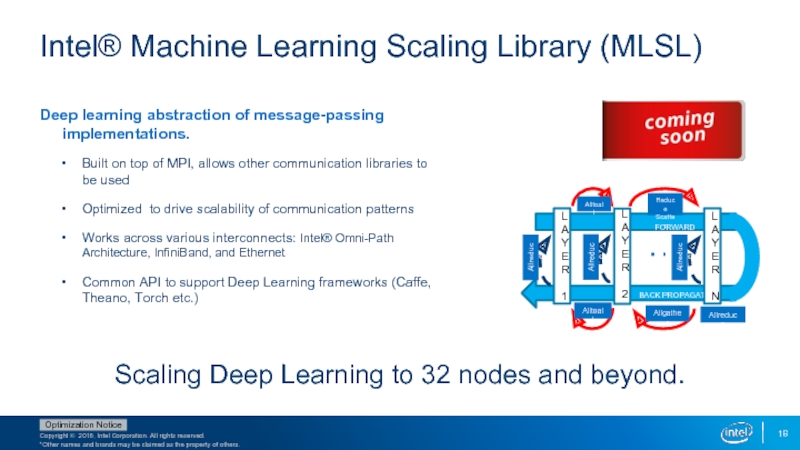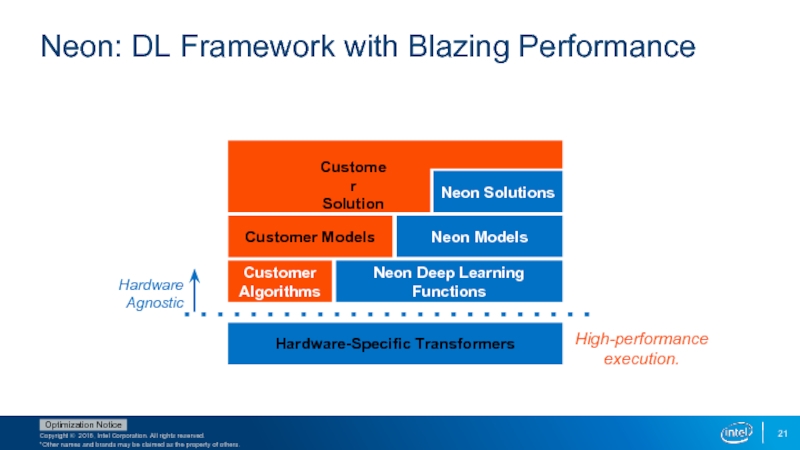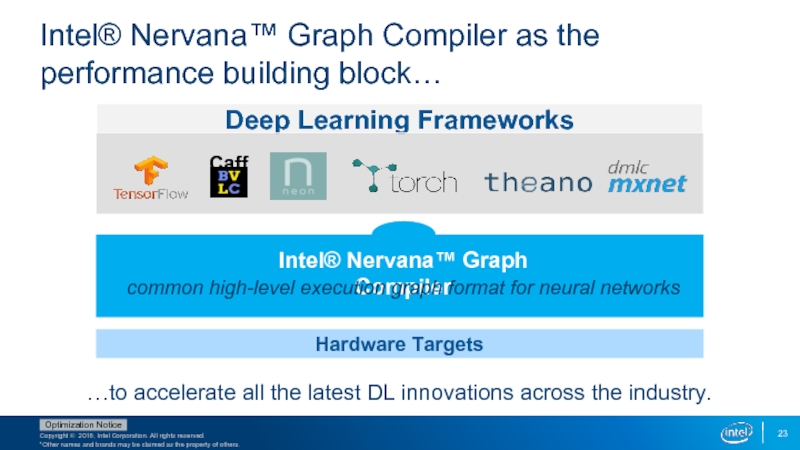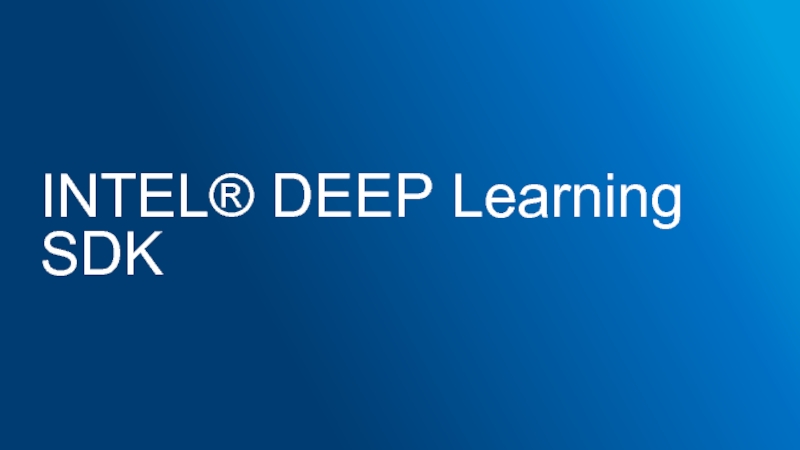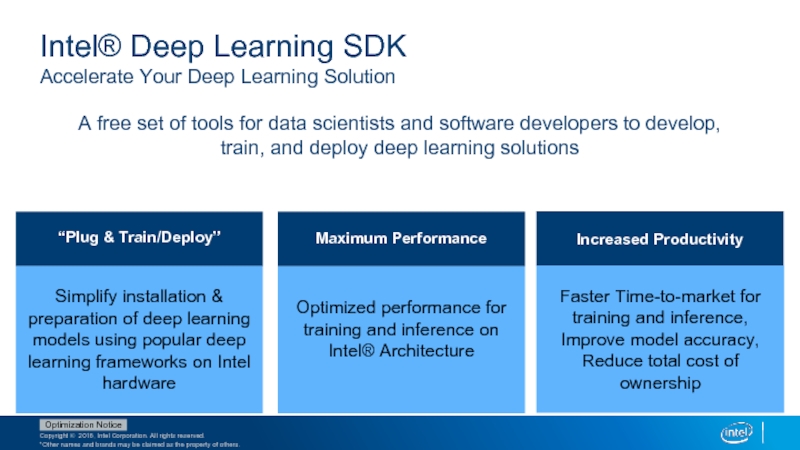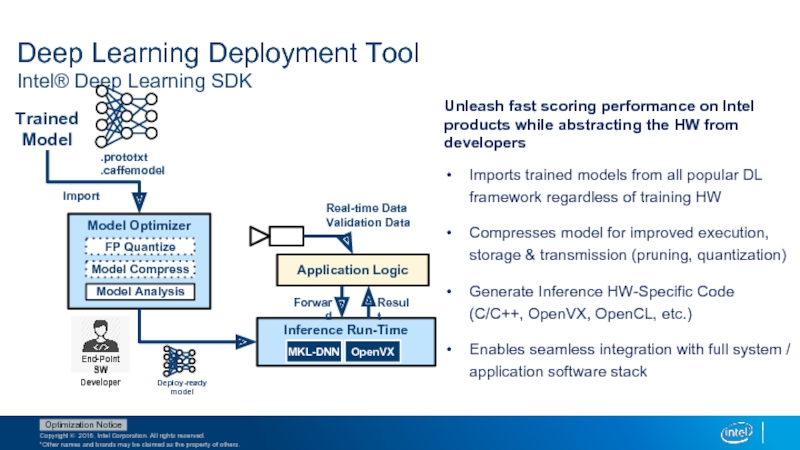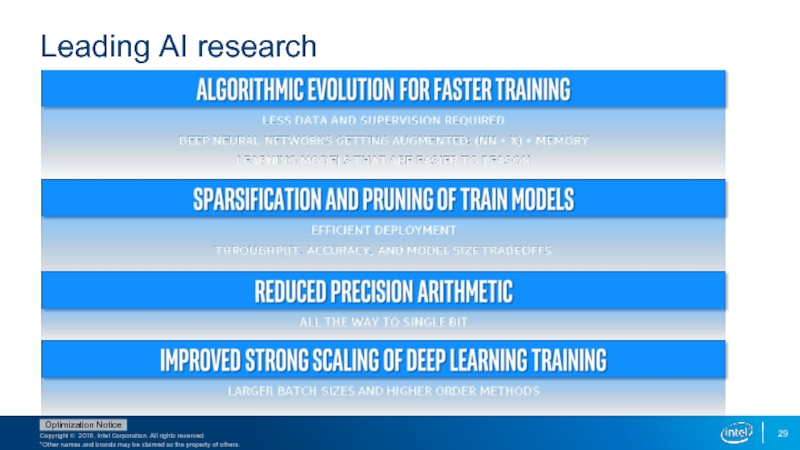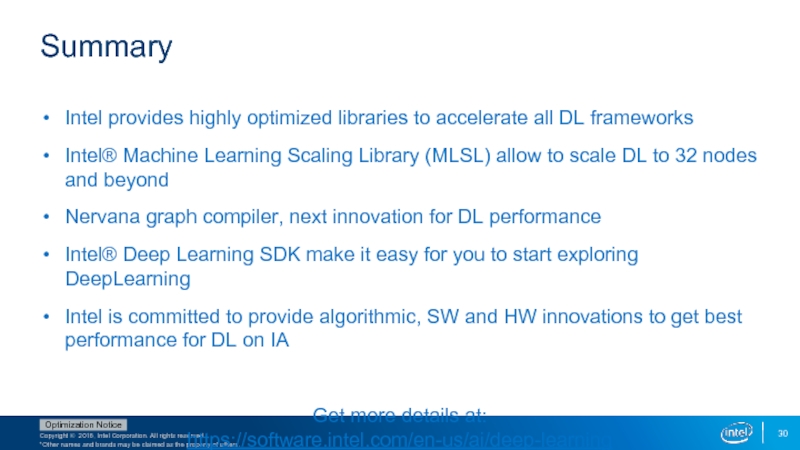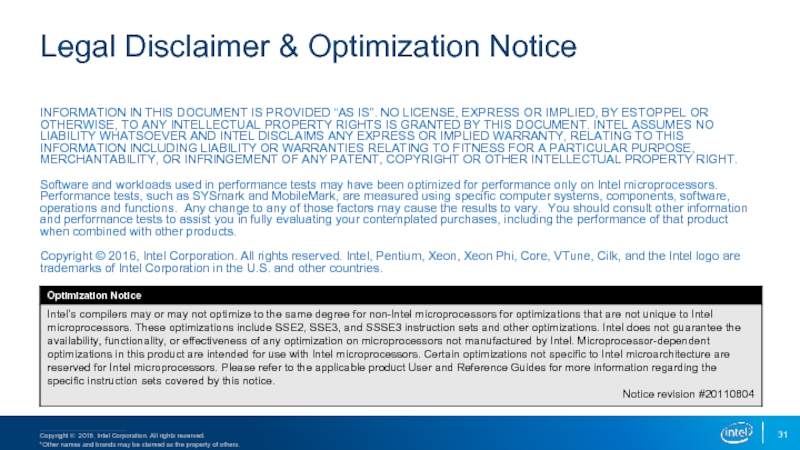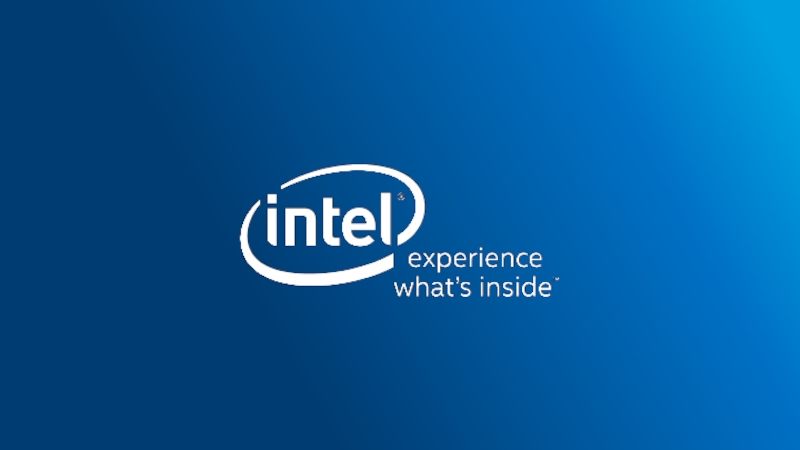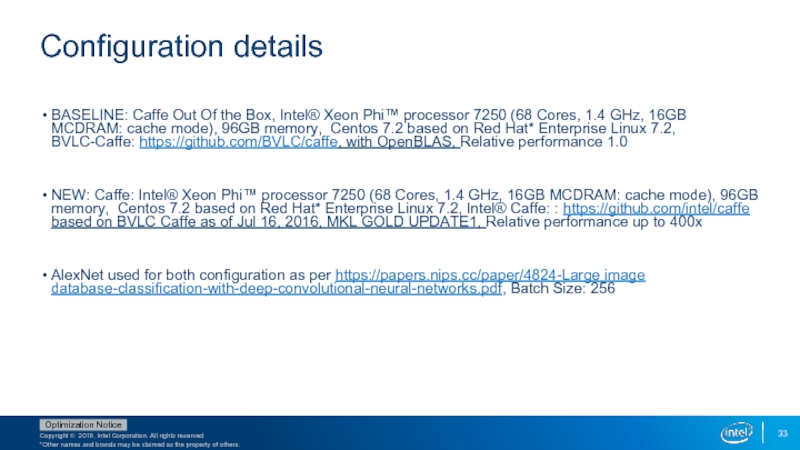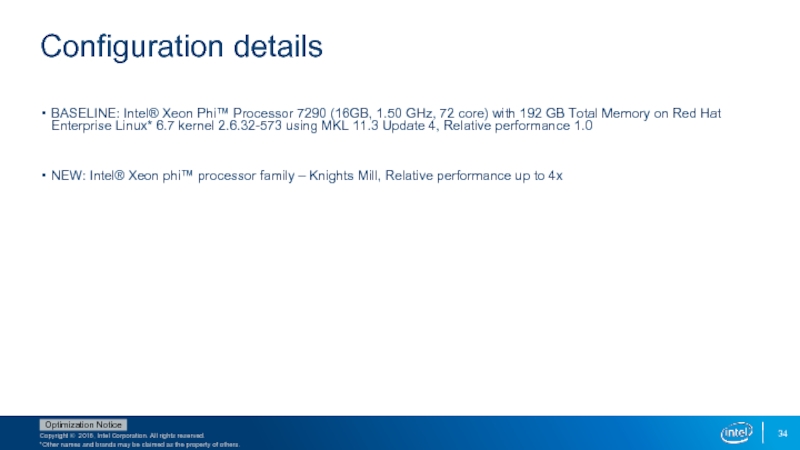- Главная
- Разное
- Дизайн
- Бизнес и предпринимательство
- Аналитика
- Образование
- Развлечения
- Красота и здоровье
- Финансы
- Государство
- Путешествия
- Спорт
- Недвижимость
- Армия
- Графика
- Культурология
- Еда и кулинария
- Лингвистика
- Английский язык
- Астрономия
- Алгебра
- Биология
- География
- Детские презентации
- Информатика
- История
- Литература
- Маркетинг
- Математика
- Медицина
- Менеджмент
- Музыка
- МХК
- Немецкий язык
- ОБЖ
- Обществознание
- Окружающий мир
- Педагогика
- Русский язык
- Технология
- Физика
- Философия
- Химия
- Шаблоны, картинки для презентаций
- Экология
- Экономика
- Юриспруденция
High Performance Deep Learning on Intel Architecture презентация
Содержание
- 1. High Performance Deep Learning on Intel Architecture
- 3. Classical Machine Learning
- 4. Deep learning A
- 5. End-to-End Deep Learning ~60 million parameters
- 6. Automating previously “human” tasks Human Performance
- 7. ( 1 ) Large compute requirements for training Deep Learning Challenges
- 8. ( 2 ) Performance scales with data Deep Learning Challenges
- 9. Scaling is I/O Bound # OF PROCESSORS
- 10. Intel Provides the Compute Foundation for DL Deep Learning Frameworks
- 11. INTEL® MKL-DNN
- 12. Deep learning with Intel® MKL-DNN Intel®
- 13. Deep learning with Intel® MKL-DNN Intel® MKL-DNN
- 14. Deep learning with Intel® MKL-DNN Intel® MKL-DNN
- 15. Intel® Xeon Phi ™ processor 7250 up
- 16. Intel® Xeon Phi ™ processor Knights Mill
- 17. INTEL® Machine Learning Scaling Library
- 18. Intel® Machine Learning Scaling Library (MLSL) Deep
- 19. Intel® Xeon Phi™ Processor 7250 GoogleNet V1
- 20. NeON framework
- 21. Neon: DL Framework with Blazing Performance
- 22. Intel® Nervana™ Graph Compiler Intel® Nervana™ Graph
- 23. Intel® Nervana™ Graph Compiler as the performance
- 24. INTEL® DEEP Learning SDK
- 25. Increased Productivity Faster Time-to-market for training and
- 26. Deep Learning Training Tool Intel® Deep Learning
- 27. Deep Learning Deployment Tool Intel® Deep Learning
- 28. Deep Learning Tools for End-to-End Workflow Intel®
- 29. Leading AI research
- 30. Summary Intel provides highly optimized libraries to
- 31. Legal Disclaimer & Optimization Notice INFORMATION IN
- 33. Configuration details BASELINE: Caffe Out Of the
- 34. Configuration details BASELINE: Intel® Xeon Phi™ Processor
- 35. Configuration details 32 nodes of Intel® Xeon
Слайд 1High Performance Deep Learning on Intel® Architecture
Ivan Kuzmin
Engineering Manager for
December 19, 2016
Слайд 2
Bigger Data
Better Hardware
Smarter Algorithms
Fast Evolution of Technology
Image: 1000 KB / picture
Audio:
Video: 5,000,000 KB / movie
Transistor density doubles every 18 months
Cost / GB in 1995: $1000.00
Cost / GB in 2015: $0.03
Advances in neural networks leading to better accuracy in training models
Слайд 3
Classical Machine Learning
CLASSIFIER
SVM
Random Forest
Naïve Bayes
Decision Trees
Logistic Regression
Ensemble methods
Arjun
Слайд 4Deep learning
A method of extracting features at multiple levels
of abstraction
Features are
Performance improves with more data
High degree of representational power
Слайд 5
End-to-End Deep Learning
~60 million parameters
But old practices apply:
Data Cleaning, Exploration,
Arjun
Слайд 6Automating previously “human” tasks
Human
Performance
2010
Present
ImageNet Error Rate
Using Deep Learning
2000
Present
Speech Error Rate
Слайд 9Scaling is I/O Bound
# OF PROCESSORS
LEARNING SPEED
INDUSTRY STANDARD: COMMUNICATION
PERFORMANCE CEILING
NERVANA TECHNOLOGY:
BETTER COMMUNICATION
FABRIC, NEAR
LINEAR SCALING
Слайд 12
Deep learning with Intel® MKL-DNN
Intel® MKL
SW building block to extract
Provide common interface to all Intel® CPUs.
Variety of popular Deep Learning frameworks
Deep Learning Frameworks
*Other names and brands may be claimed as property of others.
Intel®
MKL-DNN
Intel® Math Kernel Library
(Intel® MKL)
Host &
Offload
Intel® MKL-DNN and Intel® MKL – path to bring performance to DL frameworks on Intel® CPU
Слайд 13Deep learning with Intel® MKL-DNN
Intel® MKL-DNN
Tech preview, https://01.org/mkl-dnn
Demonstrates interfaces and the
Single precision
Plan to enable more primitives to support additional topologies
Plan more optimizations for latest generation of Intel® CPU
Слайд 14Deep learning with Intel® MKL-DNN
Intel® MKL-DNN Programming Model
Primitive – any operation
Operation/memory descriptor - convolution parameters, memory dimensions
Descriptor - complete description of a primitive
Primitive – a specific instance of a primitive relying on descriptor
Engine – execution device (e.g., CPU)
Stream – execution context
/* Initialize CPU engine */
auto cpu_engine = mkldnn::engine(mkldnn::engine::cpu, 0);
/* Create a vector of primitives */
std::vector
/* Allocate input data and create a tensor structure that describes it */
std::vector
mkldnn::tensor::dims conv_src_dims = {2, 3, 227, 227};
/* Create memory descriptors, one for data and another for convolution input */
auto user_src_md = mkldnn::memory::desc({conv_src_dims},
mkldnn::memory::precision::f32, mkldnn::memory::format::nchw);
auto conv_src_md = mkldnn::memory::desc({conv_src_dims},
mkldnn::memory::precision::f32, mkldnn::memory::format::any);
/* Create convolution descriptor */
auto conv_desc = mkldnn::convolution::desc(
mkldnn::prop_kind::forward, mkldnn::convolution::direct,
conv_src_md, conv_weights_md, conv_bias_md, conv_dst_md,
{1, 1}, {0, 0}, mkldnn::padding_kind::zero);
/* Create a convolution primitive descriptor */
auto conv_pd = mkldnn::convolution::primitive_desc(conv_desc, cpu_engine);
/* Create a memory descriptor and primitive */
auto user_src_memory_descriptor
= mkldnn::memory::primitive_desc(user_src_md, engine);
auto user_src_memory = mkldnn::memory(user_src_memory_descriptor, src);
/* Create a convolution primitive and add it to the net */
auto conv = mkldnn::convolution(conv_pd, conv_input, conv_weights_memory,
conv_user_bias_memory, conv_dst_memory);
net.push_back(conv);
/* Create a stream, submit all primitives and wait for completion */
mkldnn::stream().submit(net).wait();
Слайд 15Intel® Xeon Phi ™ processor 7250 up to 400x performance increase
Normalized Images/Second on Intel® Xeon Phi™ processor 7250 baseline
Higher is better
Up to 400x
Configuration details available in backup
Optimization Notice: Intel's compilers may or may not optimize to the same degree for non-Intel microprocessors for optimizations that are not unique to Intel microprocessors. These optimizations include SSE2, SSE3, and SSSE3 instruction sets and other optimizations. Intel does not guarantee the availability, functionality, or effectiveness of any optimization on microprocessors not manufactured by Intel. Microprocessor-dependent optimizations in this product are intended for use with Intel microprocessors. Certain optimizations not specific to Intel microarchitecture are reserved for Intel microprocessors. Please refer to the applicable product User and Reference Guides for more information regarding the specific instruction sets covered by this notice. Notice Revision #20110804
Software and workloads used in performance tests may have been optimized for performance only on Intel microprocessors. Performance tests, such as SYSmark and MobileMark, are measured using specific computer systems, components, software, operations and functions. Any change to any of those factors may cause the results to vary. You should consult other information and performance tests to assist you in fully evaluating your contemplated purchases, including the performance of that product when combined with other products. For more complete information visit: http://www.intel.com/performance Source: Intel measured as of November 2016
Слайд 16Intel® Xeon Phi ™ processor Knights Mill up to 4x estimated
Estimated normalized performance on Intel® Xeon Phi™ processor 7290 compared to Intel® Xeon Phi™ Knights Mill
Up to 4x
Configuration details available in backup
Knights Mill performance: Results have been estimated or simulated using internal Intel analysis or architecture simulation or modeling, and provided to you for informational purposes. Any differences in your system hardware, software or configuration may affect your actual performance.
Optimization Notice: Intel's compilers may or may not optimize to the same degree for non-Intel microprocessors for optimizations that are not unique to Intel microprocessors. These optimizations include SSE2, SSE3, and SSSE3 instruction sets and other optimizations. Intel does not guarantee the availability, functionality, or effectiveness of any optimization on microprocessors not manufactured by Intel. Microprocessor-dependent optimizations in this product are intended for use with Intel microprocessors. Certain optimizations not specific to Intel microarchitecture are reserved for Intel microprocessors. Please refer to the applicable product User and Reference Guides for more information regarding the specific instruction sets covered by this notice. Notice Revision #20110804
Software and workloads used in performance tests may have been optimized for performance only on Intel microprocessors. Performance tests, such as SYSmark and MobileMark, are measured using specific computer systems, components, software, operations and functions. Any change to any of those factors may cause the results to vary. You should consult other information and performance tests to assist you in fully evaluating your contemplated purchases, including the performance of that product when combined with other products. For more complete information visit: http://www.intel.com/performance Source: Intel measured baseline Intel® Xeon Phi™ processor 7290 as of November 2016
Слайд 18Intel® Machine Learning Scaling Library (MLSL)
Deep learning abstraction of message-passing implementations.
Built
Optimized to drive scalability of communication patterns
Works across various interconnects: Intel® Omni-Path Architecture, InfiniBand, and Ethernet
Common API to support Deep Learning frameworks (Caffe, Theano, Torch etc.)
Scaling Deep Learning to 32 nodes and beyond.
Слайд 19Intel® Xeon Phi™ Processor 7250 GoogleNet V1 Time-To-Train Scaling Efficiency
Time to Train Scaling Efficiency
On Intel® Xeon Phi™ 7250 nodes
Configuration details available in backup
Optimization Notice: Intel's compilers may or may not optimize to the same degree for non-Intel microprocessors for optimizations that are not unique to Intel microprocessors. These optimizations include SSE2, SSE3, and SSSE3 instruction sets and other optimizations. Intel does not guarantee the availability, functionality, or effectiveness of any optimization on microprocessors not manufactured by Intel. Microprocessor-dependent optimizations in this product are intended for use with Intel microprocessors. Certain optimizations not specific to Intel microarchitecture are reserved for Intel microprocessors. Please refer to the applicable product User and Reference Guides for more information regarding the specific instruction sets covered by this notice. Notice Revision #20110804
Software and workloads used in performance tests may have been optimized for performance only on Intel microprocessors. Performance tests, such as SYSmark and MobileMark, are measured using specific computer systems, components, software, operations and functions. Any change to any of those factors may cause the results to vary. You should consult other information and performance tests to assist you in fully evaluating your contemplated purchases, including the performance of that product when combined with other products. For more complete information visit: http://www.intel.com/performance Source: Intel measured as of November 2016
Data pre-partitioned across all nodes in the cluster before training. There is no data transferred over the fabric while training.
Number of Intel® Xeon Phi™ Processor 7250 nodes
Слайд 22Intel® Nervana™ Graph Compiler
Intel® Nervana™ Graph Compiler:
High-level execution graph
for neural
Hardware-Specific Transformers
Hardware
Agnostic
Intel® Nervana™ Graph Compiler
Customer
Solution
Neon Solutions
Neon Models
Customer Models
Neon Deep Learning Functions
Customer Algorithms
Efficient buffer allocation
Training vs inference optimizations
Efficient scaling across multiple nodes
Efficient partitioning of subgraphs
Compounding of ops
Слайд 23Intel® Nervana™ Graph Compiler as the performance building block…
…to accelerate
Слайд 25Increased Productivity
Faster Time-to-market for training and inference,
Improve model accuracy,
Reduce total
Maximum Performance
Optimized performance for training and inference on Intel® Architecture
Intel® Deep Learning SDK
Accelerate Your Deep Learning Solution
A free set of tools for data scientists and software developers to develop, train, and deploy deep learning solutions
How to setup Intel Caffe guide
“Plug & Train/Deploy”
Simplify installation & preparation of deep learning models using popular deep learning frameworks on Intel hardware
Слайд 26Deep Learning Training Tool
Intel® Deep Learning SDK
Simplify installation of Intel optimized
Easy and Visual way to Set-up, Tune and Run Deep Learning Algorithms:
Create training dataset
Design model with automatically optimized hyper-parameters
Launch and monitor training of multiple candidate models
Visualize training performance and accuracy
DL Framework
Datacenter
MKL-DNN
DL Training Tool
Dataset
Install
Configure
Run
Accuracy
Utilization
Model
.prototxt
.caffemodel
Trained
Model
Data Scientist
Label
Слайд 27Deep Learning Deployment Tool
Intel® Deep Learning SDK
Unleash fast scoring performance on
Imports trained models from all popular DL framework regardless of training HW
Compresses model for improved execution, storage & transmission (pruning, quantization)
Generate Inference HW-Specific Code (C/C++, OpenVX, OpenCL, etc.)
Enables seamless integration with full system / application software stack
.prototxt
.caffemodel
Trained
Model
Model Optimizer
FP Quantize
Model Compress
Import
Inference Run-Time
OpenVX
Application Logic
Forward
Result
Real-time Data
Validation Data
Model Analysis
MKL-DNN
Deploy-ready
model
Слайд 28Deep Learning Tools for End-to-End Workflow
Intel® Deep Learning SDK
MKL-DNN Optimized Machine
Intel DL Training Tool
Intel DL Deployment Tool
IMPORT Trained Model (trained on Intel or 3rd Party HW)
COMPRESS Model for Inference on Target Intel HW
GENERATE Inference HW-Specific Code (OpenVX, C/C++)
INTEGRATE with System SW / Application Stack & TUNE
EVALUATE Results and ITERATE
INSTALL / SELECT
IA-Optimized Frameworks
PREPARE / CREATE Dataset with Ground-truth
DESIGN / TRAIN Model(s) with IA-Opt. Hyper-Parameters
MONITOR Training Progress across Candidate Models
EVALUATE Results and ITERATE
configure_nn(fpga/,…)
allocate_buffer(…)
fpga_conv(input,output);
fpga_conv(…);
mkl_SoftMax(…);
mkl_SoftMax(…);
…
Xeon (local or cloud)
Optimized libraries & run-times (MKL-DNN, OpenVX, OpenCL)
Data acquisition (sensors) and acceleration HW (FPGA, etc)
Target Inference Hardware Platform (physical or simulated)
Слайд 30Summary
Intel provides highly optimized libraries to accelerate all DL frameworks
Intel® Machine
Nervana graph compiler, next innovation for DL performance
Intel® Deep Learning SDK make it easy for you to start exploring DeepLearning
Intel is committed to provide algorithmic, SW and HW innovations to get best performance for DL on IA
Get more details at: https://software.intel.com/en-us/ai/deep-learning
Слайд 31Legal Disclaimer & Optimization Notice
INFORMATION IN THIS DOCUMENT IS PROVIDED “AS
Software and workloads used in performance tests may have been optimized for performance only on Intel microprocessors. Performance tests, such as SYSmark and MobileMark, are measured using specific computer systems, components, software, operations and functions. Any change to any of those factors may cause the results to vary. You should consult other information and performance tests to assist you in fully evaluating your contemplated purchases, including the performance of that product when combined with other products.
Copyright © 2016, Intel Corporation. All rights reserved. Intel, Pentium, Xeon, Xeon Phi, Core, VTune, Cilk, and the Intel logo are trademarks of Intel Corporation in the U.S. and other countries.
Слайд 33Configuration details
BASELINE: Caffe Out Of the Box, Intel® Xeon Phi™ processor
NEW: Caffe: Intel® Xeon Phi™ processor 7250 (68 Cores, 1.4 GHz, 16GB MCDRAM: cache mode), 96GB memory, Centos 7.2 based on Red Hat* Enterprise Linux 7.2, Intel® Caffe: : https://github.com/intel/caffe based on BVLC Caffe as of Jul 16, 2016, MKL GOLD UPDATE1, Relative performance up to 400x
AlexNet used for both configuration as per https://papers.nips.cc/paper/4824-Large image database-classification-with-deep-convolutional-neural-networks.pdf, Batch Size: 256
Слайд 34Configuration details
BASELINE: Intel® Xeon Phi™ Processor 7290 (16GB, 1.50 GHz, 72
NEW: Intel® Xeon phi™ processor family – Knights Mill, Relative performance up to 4x
Слайд 35Configuration details
32 nodes of Intel® Xeon Phi™ processor 7250 (68 Cores,
Intel® Caffe: Intel internal version of Caffe
GoogLeNetV1: http://static.googleusercontent.com/media/research.google.com/en//pubs/archive/43022.pdf, batch size 1536
Public
